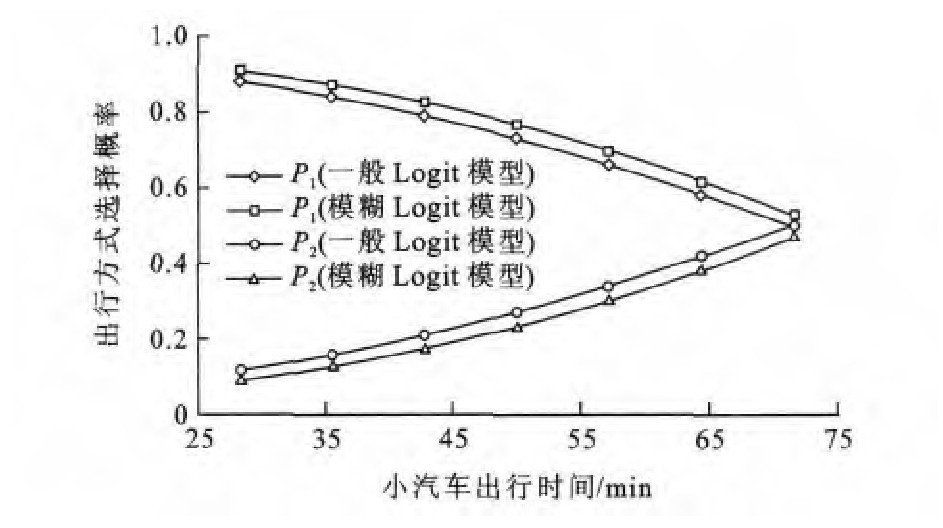-
摘要: 基于非集计模型与模糊数学理论, 以城市群居民出行行为为研究对象, 选择出行者的出行时间和出行费用作为影响因素, 利用极大似然估计法进行参数标定, 通过t检验、命中率检验与优度检验, 将出行时间模糊化, 忽略出行费用的影响, 建立了具有模糊特性变量的出行方式预测Logit模型。将轨道交通与小汽车2种出行方式的时间模糊化参数分别选为0.1、0.3、0.5, 分析了出行方式与出行时间对居民出行行为的影响。分析结果表明: 轨道交通与小汽车的平均出行感知时间之比为0.8~1.2, 且2种出行感知时间同等程度变化; 当轨道交通出行时间模糊化参数为0.1, 小汽车出行时间小于70 min时, 出行者均选择轨道交通出行; 当轨道交通出行时间模糊化参数为0.3, 小汽车出行时间小于67 min时, 出行者继续选择轨道交通出行, 但当小汽车出行时间大于67 min, 小汽车出行时间模糊化参数分别为0.1、0.3时, 出行者选择小汽车出行; 当轨道交通出行时间模糊化参数为0.5, 小汽车出行时间小于58 min时, 出行者仍然选择轨道交通出行, 但当小汽车出行时间大于66 min时, 出行者均选择小汽车出行。Abstract: Based on the disaggregate model and fuzzy mathematics theory, the trip behaviors of residents in urban agglomeration were taken as study subject, the trip time and the trip cost were taken as influence factors, and the parameters were calibrated by the maximum likelihood estimation method. Through t test, hit rate test and fit goodness test, the trip time was fuzzed, the influence of trip cost was ignored, and a predicative logit model of trip mode with fuzzy attribute variables was established. The fuzzy parameters of trip times for rail transit and car were chosen as 0.1, 0.3 and 0.5 respectively, the influences of trip mode and trip time on trip behavior for residents were analyzed.Analysis result shows that the average trip perception time ratio of rail transit and car is between 0.8 and 1.2, and the two trip perception times change in equal degree. When the fuzzy parameter of trip time for rail transit is 0.1 and the trip time of car is less than 70 min, all the residents will choose rail transit. When the fuzzy parameter of trip time for rail transit is 0.3 and the trip time of car is less than 67 min, residents still choose rail transit, but when the trip time of car is more than 67 min and the fuzzy parameter of trip time for car is 0.1 and 0.3 respectively, residents will choose car.When the fuzzy parameter of trip time for rail transit is 0.5 and the trip time of car is less than 58 min, residents still choose rail transit, while the trip time of car is more than 66 min, all the residents choose car.
-
Key words:
- traffic planning /
- resident trip /
- trip mode /
- logit model /
- fuzzy attribute variable /
- triangle center
-
表 1 一般Logit模型参数
Table 1. Parameters of common logit model

表 2 修正后的参数
Table 2. Parameters affer rectification

表 3 模糊Logit模型参数
Table 3. Parameters of fuzzy logit model

-
[1] MURTHY A S N, ASHTAKALA B. Modal split analysis using logit models[J]. Journal of Transportation Engineering, 1987, 113(5): 502-519. doi: 10.1061/(ASCE)0733-947X(1987)113:5(502) [2] 刘彤, 巩丽媛, 郑建, 等. Logit模型的推导方法研究[J]. 科学技术与工程, 2009, 9(2): 357-359. doi: 10.3969/j.issn.1671-1815.2009.02.029LIU Tong, GONG Li-yuan, ZHENG Jian, et al. Study on deviation of logit model[J]. Science Technology and Engineering, 2009, 9(2): 357-359. (in Chinese). doi: 10.3969/j.issn.1671-1815.2009.02.029 [3] 李辰. 交通方式划分的Logit模型方法[D]. 南京: 河海大学, 2004.LI Chen. Method of logit model in traffic model-split[D]. Nanjing: Hohai University, 2004. (in Chinese). [4] MCFADDEN D, TRAIN K. Mixed MNL models for discrete response[J]. Journal of Applied Econometrics, 2000, 15(5): 447-470. doi: 10.1002/1099-1255(200009/10)15:5<447::AID-JAE570>3.0.CO;2-1 [5] BOYD J H, MELLMAN R E. The effect of fuel economy standards on the U. S. automotive market: an hedonic demand analysis[J]. Transportation Research Part A: Policy and Practice, 1980, 14(5/6): 367-378. [6] CARDELL N S, DUNBAR F C. Measuring the societal impacts of automobile down-sizing[J]. Transportation Research Part A: Policy and Practice, 1980, 14(5/6): 423-434. [7] TRAIN K, MCFADDEN D, BEN-AKIVA M. The demand for local telephone service: a fully discrete model of residential calling patterns and service choice[J]. Rand Journal of Economics, 1987, 18(1): 109-123. doi: 10.2307/2555538 [8] BEN-AKIVA M, BOLDUC D, BRADLEY M. Estimation of travel choice models with randomly distributed values of time[J]. Transportation Research Record, 1993(1413): 88-97. [9] BHAT C R. Accommodating variations in responsiveness to level-of-service measures in travel mode choice models[J]. Transportation Research Part A: Policy and Practice, 1998, 32(7): 495-507. doi: 10.1016/S0965-8564(98)00011-1 [10] BROWNSTONE D, TRAIN K. Forecasting new product penetration with flexible substitution patterns[J]. Journal of Econometrics, 1999, 89(1/2): 109-129. [11] ERDEM T. A dynamic analysis of market structure based on panel data[J]. Marketing Science, 1996, 15(4): 359-378. doi: 10.1287/mksc.15.4.359 [12] REVELT D, TRAIN K. Mixed logit with repeated choices: householdschoices of appliance efficiency level[J]. The Review of Economics and Statistics, 1998, 80(4): 647-657. doi: 10.1162/003465398557735 [13] BHAT C R. Incorporating observed and unobserved heterogeneity in urban work mode choice modeling[J]. Transportation Science, 2000, 34(2): 228-238. doi: 10.1287/trsc.34.2.228.12306 [14] CHESHER A, SANTOSSILVA J M C. Taste variation in discrete choice models[J]. The Review of Economic Studies, 2002, 69(1): 147-168. doi: 10.1111/1467-937X.00201 [15] ANDREWS R L, AINSLIE A, CURRIM I S. An empirical comparison of logit choice models with discrete versus continuous representation of heterogeneity[J]. Journal of Marketing Research, 2002, 39(4): 479-487. doi: 10.1509/jmkr.39.4.479.19124 [16] WILLIAMS H C W L. On the formation of travel demand models and economic evaluation measures of user benefit[J]. Environment and Planning A, 1977, 9(3): 285-344. doi: 10.1068/a090285 [17] 杨励雅, 邵春福, HAGHANI A. 出行方式与出发时间联合选择的分层Logit模型[J]. 交通运输工程学报, 2012, 12(2): 76-83. doi: 10.3969/j.issn.1671-1637.2012.02.013YANG Li-ya, SHAO Chun-fu, HAGHANI A. Nested logit model of combined selection for travel mode and departure time[J]. Journal of Traffic and Transportation Engineering, 2012, 12(2): 76-83. (in Chinese). doi: 10.3969/j.issn.1671-1637.2012.02.013 [18] BOX G E P, COX D R. An analysis of transformations[J]. Journal of the Royal Statistical Society, 1964, 26(2): 211-252. [19] GAUNDRY M J I, DAGENAIS M G. The dogit model[J]. Transportation Research Part B: Methodological, 1979, 13(2): 105-111. doi: 10.1016/0191-2615(79)90028-6 [20] GERKEN J. Generalized logit model[J]. Transportation Research Part B: Methodological, 1991, 25(2): 75-88. [21] VOVSHA P. Application of cross-nested logit model to mode choice in Tel Aviv, Israel, metropolitan area[J]. Transportation Research Record, 1997(1607): 6-15. [22] KOPPELMAN F S, WEN C H. The paired combinatorial logit model: properties, estimation and application[J]. Transportation Research Part B: Methodological, 2000, 34(2): 75-89. doi: 10.1016/S0191-2615(99)00012-0 [23] SWAIT J, ADAMOWICZ W. The effect of choice environment and task demands on consumer behavior: discriminating between contribution and confusion[R]. Edmonton: University of Alberta, 1996. [24] BHAT C R. Covariance heterogeneity in nested logit models: econometric structure and application to intercity travel[J]. Transportation Research Part B: Methodological, 1997, 31(1): 11-21. [25] WEN C H, KOPPELMAN F S. The generalized nested logit model[J]. Transportation Research Part B: Methodological, 2001, 35(7): 627-641. [26] 罗丽君, 裴玉龙. 模糊随机动态交通分配模型研究[J]. 华中科技大学学报: 城市科学版, 2002, 19(2): 64-67. https://www.cnki.com.cn/Article/CJFDTOTAL-WHCJ200202017.htmLUO Li-jun, PEI Yu-long. Study on fuzzy random dynamic traffic assignment model[J]. Journal of Huazhong University of Science and Technology: Urban Science Edition, 2002, 19(2): 64-67. (in Chinese). https://www.cnki.com.cn/Article/CJFDTOTAL-WHCJ200202017.htm [27] LIU H X, BAN Xue-gang, RAN Bin, et al. A formulation and solution algorithm for a fuzzy dynamic traffic assignment model[J]. Transportation Research Record, 2003(1854): 114-123. -





 下载:
下载:





